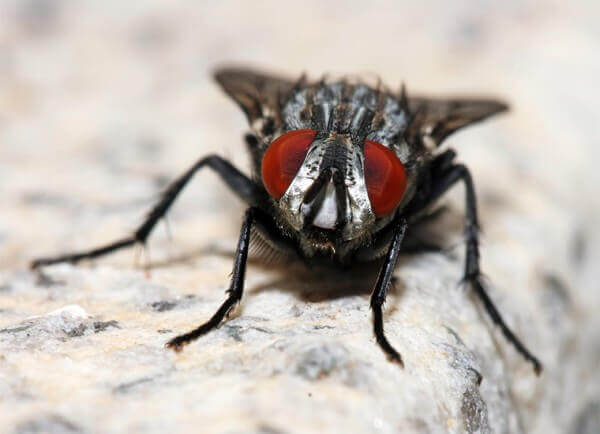What Do Filth Flies Look Like?

Filth flies include a broad array of fly species in varying sizes. Larger house and blow flies can measure up to one-third inch long, while tiny humpbacked phorid flies and tiny, fuzzy drain flies range between one-sixteenth and a quarter inch in length.
Along with size, checking for color, markings, and eye placement can identify these flies. Many of these pests are dark gray or black with a blue or green metallic sheen. Some species have stripes down their backs or checkerboard patterns on their abdomens. Although both genders sport large, red eyes, female filth flies have two and males have a single, conjoined eye.
How Can I Tell if I Have a Filth Fly Problem?
It’s common to see one or two of these pests indoors, but some signs may suggest a more serious filth fly infestation:
- Swarms – Female filth flies can lay up to 500 eggs over four days. Spotting a large number of flies in the kitchen, dining area, or office means you may have an issue with this pest.
- Larvae – Filth flies deposit eggs near moist areas with a food source. Small, cream-colored maggots emerge, often gathering in litter boxes, trash cans, and sinks full of dirty dishes.
- Garbage – The strong odors of decaying food and fresh pet waste attract these flying insects. If there are animal droppings or open trash bins in your yard, there’s a chance many different types of flies are nearby.
How Do Filth Flies Get Inside Homes and Businesses?
Open doors, torn screens, and gaps around window frames give flies and other pests easy access to houses. While a single pest may wander inside by accident, crumbs, spills, garbage, and water damage often draw larger numbers indoors. You may also notice a swarm of filth flies outside near compost piles or gardens.
Filth flies move into businesses that store or prepare food as well, making restaurants, hotels, and office kitchens prime breeding grounds. These flies occupy break rooms and cafeterias where scraps accumulate and trash sits undisturbed.
Are Filth Flies Dangerous?
Flies buzzing around your house or workplace are more than just a nuisance and an eyesore. Filth fly issues in houses, schools, and restaurants can result in illness.
Filth flies pick up harmful bacteria, such as Salmonella and E. coli, from the rotten food and waste they consume. Since the pests defecate and leave behind saliva wherever they land, pathogens can spread easily. Homeowners, students, and customers may develop food poisoning or dysentery from eating meals contaminated by a this fly.
How Can I Prevent Filth Fly Infestations?
Sanitation plays a major role in avoiding a filth fly infestation. In kitchens, dining rooms, and cafeterias, promptly dispose of trash that will rot or spoil. Also, make sure to seal garbage lids, doors, and unscreened windows when not in use.
Because there are many types of filth flies with different breeding habits, it’s best to consult a pest control professional to identify and remove the problem. If you suspect flies or any other pest are infesting your home or business, contact the skilled team at Waltham Pest Services.